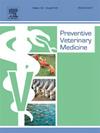猪星状病毒全球流行:一项系统综述和荟萃分析
IF 2.2
2区 农林科学
Q1 VETERINARY SCIENCES
引用次数: 0
摘要
猪星状病毒(PAstV)是一种在猪体内广泛传播的肠道病毒,常与其他肠道病毒共感染并导致腹泻,给全球养猪业造成重大经济损失。本研究旨在通过对全球数据进行统计荟萃分析并评估不同亚组间的异质性,确定影响PAstV患病率的因素。系统检索PubMed、Web of Science、CNKI、万方和VIP数据库的文献,涵盖从数据库建立到2023年12月的研究。采用随机效应模型估计全球PAstV感染的总流行率,并进行亚组分析以评估不同大陆、年份、检测方法和样本类型对流行率的影响。采用漏斗图和Egger检验评估发表偏倚。荟萃分析共纳入了来自三大洲10个国家的45项研究,涉及376篇文章。全球PAstV感染总流行率为28.19 %(95% % CI, 21.94 %-34.89 %)。亚组分析显示显著差异在跨洲PAstV患病率,与亚洲26.25 %(95 % CI, 25.41 % -27.09 %),欧洲在36.19 %(95 % CI, 34.09 % -38.33 %),和北美63.24 %。2012 - 2014年PAstV患病率最高(49.86 %,95% % CI, 47.21 %-52.51 %),2015 - 2023年呈下降趋势,稳定在30 %以下。分析显示,检测方法对PAstV患病率无显著影响。然而,非粪便样本的患病率(43.09 %,95 % CI: 41.05 %-45.15 %)显著高于粪便样本(22.92 %,95 % CI: 21.87 %-23.99 %)。此外,无症状猪的PAstV患病率(36.71 %,95 % CI, 34.97 %-38.48 %)高于腹泻猪(28.18 %,95 % CI, 26.94 %-29.44 %)。不同年龄组之间、托儿所猪(6 - 10周)展出感染率最高(63.19 % 95 % CI, 58.45 % -67.75 %),其次是断奶猪(3 - 6周)(60.00 % 95 % CI, 56.48 % -63.45 %),修整器猪(在10周)(49.89 % 95 % CI, 46.59 % -53.19 %),母猪(35.33 % 95 % CI, 31.45 % -39.37 %),哺乳猪(0 - 3周)显示率最低(31.93 % 95 % CI, 30.23 % -33.68 %)。本研究强调了全球猪群中PAstV感染的广泛性,不同地区、年份和样本类型的流行率存在显著差异。无症状感染的高流行率强调了加强埃博拉病毒监测和控制措施的必要性。本文章由计算机程序翻译,如有差异,请以英文原文为准。
Global prevalence of Porcine Astrovirus: A systematic review and meta-analysis
Porcine astrovirus (PAstV) is a widespread enteric virus in pigs, often co-infecting with other enteric viruses and contributing to diarrhea, leading to significant economic losses in the global swine industry. This study aims to identify the factors influencing PAstV prevalence by conducting a statistical meta-analysis of global data and evaluating heterogeneity across various subgroups. A systematic literature search was performed across PubMed, Web of Science, CNKI, Wanfang, and VIP databases, covering studies from the inception of the databases up to December 2023. A random-effects model was employed to estimate the global pooled prevalence of PAstV infection, and subgroup analyses were performed to evaluate the impact of different continents, years, detection methods, and sample types on the prevalence. Publication bias was assessed using a funnel plot and Egger's test. A total of 45 studies from 10 countries across three continents, involving 376 articles, were included in the meta-analysis. The global pooled prevalence of PAstV infection was found to be 28.19 % (95 % CI, 21.94 %-34.89 %). Subgroup analysis indicated significant differences in PAstV prevalence across continents, with Asia at 26.25 % (95 % CI, 25.41 %-27.09 %), Europe at 36.19 % (95 % CI, 34.09 %-38.33 %), and North America at 63.24 %. The prevalence of PAstV was highest between 2012 and 2014 (49.86 %, 95 % CI, 47.21 %-52.51 %), followed by a decreasing trend that stabilized below 30 % from 2015 to 2023. The analysis showed no significant influence of detection methods on PAstV prevalence. However, the prevalence in non-fecal samples (43.09 %, 95 % CI: 41.05 %-45.15 %) was significantly higher than in fecal samples (22.92 %, 95 % CI: 21.87 %-23.99 %). Additionally, the prevalence of PAstV in asymptomatic pigs (36.71 %, 95 % CI, 34.97 %-38.48 %) exceeded that in diarrheic pigs (28.18 %, 95 % CI, 26.94 %-29.44 %). Among different age groups, nursery pigs(6–10 weeks) exhibited the highest infection rate (63.19 %, 95 % CI, 58.45 %-67.75 %), followed by weaning pigs(3–6 weeks) (60.00 %, 95 % CI, 56.48 %-63.45 %), finisher pigs(>10 weeks) (49.89 %, 95 % CI, 46.59 %-53.19 %), sows (35.33 %, 95 % CI, 31.45 %-39.37 %), with suckling pigs(0–3 weeks) showing the lowest rate (31.93 %, 95 % CI, 30.23 %-33.68 %). This study highlights the widespread nature of PAstV infection in pig populations globally, with notable variations in prevalence across regions, years, and sample types. The high prevalence of asymptomatic infections underscores the need for enhanced PAstV surveillance and control measures.
求助全文
通过发布文献求助,成功后即可免费获取论文全文。
去求助
来源期刊

Preventive veterinary medicine
农林科学-兽医学
CiteScore
5.60
自引率
7.70%
发文量
184
审稿时长
3 months
期刊介绍:
Preventive Veterinary Medicine is one of the leading international resources for scientific reports on animal health programs and preventive veterinary medicine. The journal follows the guidelines for standardizing and strengthening the reporting of biomedical research which are available from the CONSORT, MOOSE, PRISMA, REFLECT, STARD, and STROBE statements. The journal focuses on:
Epidemiology of health events relevant to domestic and wild animals;
Economic impacts of epidemic and endemic animal and zoonotic diseases;
Latest methods and approaches in veterinary epidemiology;
Disease and infection control or eradication measures;
The "One Health" concept and the relationships between veterinary medicine, human health, animal-production systems, and the environment;
Development of new techniques in surveillance systems and diagnosis;
Evaluation and control of diseases in animal populations.
 求助内容:
求助内容: 应助结果提醒方式:
应助结果提醒方式:


